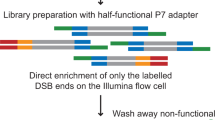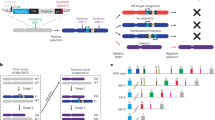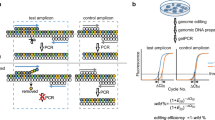Abstract
Site-specific genome engineering technologies are increasingly important tools in the postgenomic era, where biotechnological objectives often require organisms with precisely modified genomes. Rare-cutting endonucleases, through their capacity to create a targeted DNA strand break, are one of the most promising of these technologies. However, realizing the full potential of nuclease-induced genome engineering requires a detailed understanding of the variables that influence resolution of nuclease-induced DNA breaks. Here we present a genome engineering reporter system, designated 'traffic light', that supports rapid flow-cytometric analysis of repair pathway choice at individual DNA breaks, quantitative tracking of nuclease expression and donor template delivery, and high-throughput screens for factors that bias the engineering outcome. We applied the traffic light system to evaluate the efficiency and outcome of nuclease-induced genome engineering in human cell lines and identified strategies to facilitate isolation of cells in which a desired engineering outcome has occurred.
This is a preview of subscription content, access via your institution
Access options
Subscribe to this journal
Receive 12 print issues and online access
$259.00 per year
only $21.58 per issue
Buy this article
- Purchase on Springer Link
- Instant access to full article PDF
Prices may be subject to local taxes which are calculated during checkout





Similar content being viewed by others
References
Carr, P.A. & Church, G.M. Genome engineering. Nat. Biotechnol. 27, 1151–1162 (2009).
Pâques, F. & Duchateau, P. Meganucleases and DNA double-strand break-induced recombination: perspectives for gene therapy. Curr. Gene Ther. 7, 49–66 (2007).
Durai, S. et al. Zinc finger nucleases: custom-designed molecular scissors for genome engineering of plant and mammalian cells. Nucleic Acids Res. 33, 5978–5990 (2005).
Porteus, M.H. & Carroll, D. Gene targeting using zinc finger nucleases. Nat. Biotechnol. 23, 967–973 (2005).
Caldecott, K.W. Single-strand break repair and genetic disease. Nat. Rev. Genet. 9, 619–631 (2008).
Shrivastav, M., De Haro, L.P. & Nickoloff, J.A. Regulation of DNA double-strand break repair pathway choice. Cell Res. 18, 134–147 (2008).
Branzei, D. & Foiani, M. Regulation of DNA repair throughout the cell cycle. Nat. Rev. Mol. Cell Biol. 9, 297–308 (2008).
Cann, K.L. & Hicks, G.G. Regulation of the cellular DNA double-strand break response. Biochem. Cell Biol. 85, 663–674 (2007).
Porteus, M.H. & Baltimore, D. Chimeric nucleases stimulate gene targeting in human cells. Science 300, 763 (2003).
Metzger, M.J., McConnell-Smith, A., Stoddard, B.L. & Miller, A.D. Single-strand nicks induce homologous recombination with less toxicity than double-strand breaks using an AAV vector template. Nucleic Acids Res. 39, 926–935 (2011).
Bennardo, N., Cheng, A., Huang, N. & Stark, J.M. Alternative-NHEJ is a mechanistically distinct pathway of mammalian chromosome break repair. PLoS Genet. 4, e1000110 (2008).
Stark, J.M., Pierce, A.J., Oh, J., Pastink, A. & Jasin, M. Genetic steps of mammalian homologous repair with distinct mutagenic consequences. Mol. Cell. Biol. 24, 9305–9316 (2004).
Nagaraju, G., Hartlerode, A., Kwok, A., Chandramouly, G. & Scully, R. XRCC2 and XRCC3 regulate the balance between short- and long-tract gene conversions between sister chromatids. Mol. Cell. Biol. 29, 4283–4294 (2009).
Brenneman, M.A., Wagener, B.M., Miller, C.A., Allen, C. & Nickoloff, J.A. XRCC3 controls the fidelity of homologous recombination: roles for XRCC3 in late stages of recombination. Mol. Cell 10, 387–395 (2002).
Guirouilh-Barbat, J., Rass, E., Plo, I., Bertrand, P. & Lopez, B.S. Defects in XRCC4 and KU80 differentially affect the joining of distal nonhomologous ends. Proc. Natl. Acad. Sci. USA 104, 20902–20907 (2007).
Pierce, A.J., Johnson, R.D., Thompson, L.H. & Jasin, M. XRCC3 promotes homology-directed repair of DNA damage in mammalian cells. Genes Dev. 13, 2633–2638 (1999).
Aubert, M. et al. Successful targeting and disruption of an integrated reporter lentivirus using the engineered homing endonuclease Y2 I-AniI. PLoS ONE 6, e16825 (2011).
Sarkis, C., Philippe, S., Mallet, J. & Serguera, C. Non-integrating lentiviral vectors. Curr. Gene Ther. 8, 430–437 (2008).
Bennardo, N., Gunn, A., Cheng, A., Hasty, P. & Stark, J.M. Limiting the persistence of a chromosome break diminishes its mutagenic potential. PLoS Genet. 5, e1000683 (2009).
Kustikova, O.S. et al. Dose finding with retroviral vectors: correlation of retroviral vector copy numbers in single cells with gene transfer efficiency in a cell population. Blood 102, 3934–3937 (2003).
McConnell Smith, A. et al. Generation of a nicking enzyme that stimulates site-specific gene conversion from the I-AniI LAGLIDADG homing endonuclease. Proc. Natl. Acad. Sci. USA 106, 5099–5104 (2009).
Lee, G.S., Neiditch, M.B., Salus, S.S. & Roth, D.B. RAG proteins shepherd double-strand breaks to a specific pathway, suppressing error-prone repair, but RAG nicking initiates homologous recombination. Cell 117, 171–184 (2004).
Takeuchi, R., Certo, M., Caprara, M.G., Scharenberg, A.M. & Stoddard, B.L. Optimization of in vivo activity of a bifunctional homing endonuclease and maturase reverses evolutionary degradation. Nucleic Acids Res. 37, 877–890 (2009).
Matsuoka, S. et al. ATM and ATR substrate analysis reveals extensive protein networks responsive to DNA damage. Science 316, 1160–1166 (2007).
Ma, Y. & Lieber, M.R. Binding of inositol hexakisphosphate (IP6) to Ku but not to DNA-PKcs. J. Biol. Chem. 277, 10756–10759 (2002).
Kumar, A., Fernandez-Capetillo, O. & Carrera, A.C. Nuclear phosphoinositide 3-kinase β controls double-strand break DNA repair. Proc. Natl. Acad. Sci. USA 107, 7491–7496 (2010).
Guirouilh-Barbat, J. et al. Impact of the KU80 pathway on NHEJ-induced genome rearrangements in mammalian cells. Mol. Cell 14, 611–623 (2004).
Słabicki, M. et al. A genome-scale DNA repair RNAi screen identifies SPG48 as a novel gene associated with hereditary spastic paraplegia. PLoS Biol. 8, e1000408 (2010).
Pierce, A.J., Hu, P., Han, M., Ellis, N. & Jasin, M. Ku DNA end-binding protein modulates homologous repair of double-strand breaks in mammalian cells. Genes Dev. 15, 3237–3242 (2001).
Shu, X. et al. Mammalian expression of infrared fluorescent proteins engineered from a bacterial phytochrome. Science 324, 804–807 (2009).
Acknowledgements
M.T.C. was supported in part by Public Health Service, National Research Service Award, T32 GM07270, from the US National Institute of General Medical Sciences. Additional funding was from US National Institutes of Health (RL1CA133832, UL1DE019582, R01-HL075453, PL1-HL092557 and RL1-HL092553) and Seattle Children's Center for Immunity and Immunotherapies. We thank C. Ramirez and K. Joung for zinc-finger nuclease constructs (Harvard University, Massachusetts General Hospital), and all members of the Northwest Genome Engineering Consortium for their many insightful discussions.
Author information
Authors and Affiliations
Contributions
M.T.C. designed and performed experiments, analyzed data and wrote the paper; B.Y.R., J.E.A. and M.G. performed experiments; J.J. and D.J.R. designed experiments; and A.M.S. designed experiments and wrote the paper.
Corresponding authors
Ethics declarations
Competing interests
The authors declare no competing financial interests.
Supplementary information
Supplementary Text and Figures
Supplementary Figures 1–8, Supplementary Tables 1–2 and Supplementary Notes 1–2 (PDF 1345 kb)
Rights and permissions
About this article
Cite this article
Certo, M., Ryu, B., Annis, J. et al. Tracking genome engineering outcome at individual DNA breakpoints. Nat Methods 8, 671–676 (2011). https://doi.org/10.1038/nmeth.1648
Received:
Accepted:
Published:
Issue Date:
DOI: https://doi.org/10.1038/nmeth.1648
This article is cited by
-
iMUT-seq: high-resolution DSB-induced mutation profiling reveals prevalent homologous-recombination dependent mutagenesis
Nature Communications (2023)
-
Simultaneous inhibition of DNA-PK and Polϴ improves integration efficiency and precision of genome editing
Nature Communications (2023)
-
Mutation-specific reporter for optimization and enrichment of prime editing
Nature Communications (2022)
-
Deletion and replacement of long genomic sequences using prime editing
Nature Biotechnology (2022)
-
Development of transgenic Daphnia magna for visualizing homology-directed repair of DNA
Scientific Reports (2022)



